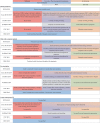Dengue, Zika and chikungunya during pregnancy: pre- and post-travel advice and clinical management
- PMID: 31616923
- PMCID: PMC6927317
- DOI: 10.1093/jtm/taz077
Dengue, Zika and chikungunya during pregnancy: pre- and post-travel advice and clinical management
Abstract
Rationale for review: Young adults of childbearing age and pregnant women are travelling more frequently to tropical areas, exposing them to specific arboviral infections such as dengue, zika and chikungunya viruses, which may impact ongoing and future pregnancies. In this narrative review, we analyse their potential consequences on pregnancy outcomes and discuss current travel recommendations.
Main findings: Dengue virus may be associated with severe maternal complications, particularly post-partum haemorrhage. Its association with adverse fetal outcomes remains unclear, but prematurity, growth retardation and stillbirths may occur, particularly in cases of severe maternal infection. Zika virus is a teratogenic infectious agent associated with severe brain lesions, with similar risks to other well-known TORCH pathogens. Implications of chikungunya virus in pregnancy are mostly related to intrapartum transmission that may be associated with severe neonatal infections and long-term morbidity.
Travel recommendations: Few agencies provide specific travel recommendations for travelling pregnant patients or couples trying to conceive and discrepancies exist, particularly regarding Zika virus prevention. The risks significantly depend on epidemiological factors that may be difficult to predict. Prevention relies principally on mosquito control measures. Couples trying to conceive and pregnant women should receive adequate information about the potential risks. It seems reasonable to advise pregnant women to avoid unnecessary travel to Aedes spp. endemic regions. The current rationale to avoid travel and delay conception is debatable in the absence of any epidemic. Post-travel laboratory testing should be reserved for symptomatic patients.
Keywords: Chikungunya; Dengue; Pregnancy; Zika.
© International Society of Travel Medicine 2019. All rights reserved. For Permissions, please e-mail: journals.permissions@oup.com.
Figures

References
-
- Wilder-Smith A, Ooi E-E, Horstick O, Wills B. Dengue. Lancet Lond Engl 2019; 393:350–63. - PubMed
-
- World Health Organization Zika epidemiology update. 2019; published online July. https://www.who.int/emergencies/diseases/zika/zika-epidemiology-update-j....
Publication types
MeSH terms
LinkOut - more resources
Full Text Sources
Medical
Miscellaneous

